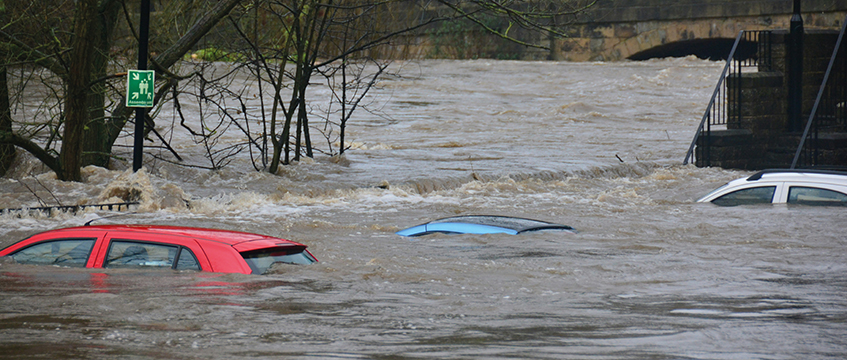James Sutherland and Oliver Radley-Gardner KC outline the unsatisfactory state of the law when it comes to flooding and other acts of nature.
Is a landowner liable if an act of nature creates a harm on their land which goes on to damage the land of a neighbour? The question is going to become increasingly pressing. The Met Office, in its online article Effects of Climate Change, notes that rising temperatures are matched by a global increase in hydrological and meteorological events. Rising sea levels mean that there is an enhanced risk of coastal flooding. Wildfires in the UK are on the increase. This means that we need to understand better how private law regulates acts of nature, and whether it is presently coherent.
‘Everyone for themselves’
For centuries, the answer the common law gave to our opening question was a simple “no”. Landowners enjoyed “natural immunity” (eg Giles v Walker (1890) 24 QBD 656), and were not liable for things naturally occurring on their land. Further, landowners were entitled to defend themselves against nature, irrespective of the harm that might cause a neighbour.
That right lies at the heart of the “common enemy” principle in water law, recognised in R v The Commissioners of Sewers for the Levels of Pagham (1828) 8 B&C 355, and reaffirmed by the Court of Appeal in Arscott v Coal Authority [2004] EWCA Civ 892; [2004] PLSCS 171. A landowner was perfectly entitled to erect flood defences, even if those cast the floodwaters onto the land of a downstream neighbour. Thus the original starting point, which still endures in some branches of the law, was “everyone for themselves”.
The erosion of natural immunity
A system built on self-help, and contingent on the resources of landowners to protect themselves, is obviously unsatisfactory. The courts initially tempered its effects by carving out anomalous exceptions. Distinctions were drawn between “natural” and “non-natural” things (particularly evident in the development of the rule in Rylands v Fletcher [1868] UKHL 1 330).
The “common enemy” principle only applied when the enemy was “at the gates”, but did not avail a landowner whose land had in fact flooded: Whalley v Lancashire and Yorkshire Railway (1884) LR 131 QB. Some of those distinctions eventually became untenable.
The sea change came with the recognition of general fault-based liability in negligence in Donoghue v Stephenson [1932] AC 562. That case set out the general principles to ascertain who, in law, was a neighbour in respect of whom care had to be taken. It was perhaps inevitable that the imposition of fault-based liability between neighbours-in-law would spill into the relations between neighbours-in-fact.
So in Sedleigh-Denfield v O’Callaghan [1940] AC 880, the House of Lords decided that a failure to fix a blocked pipe, inexpertly installed by a third party, causing flooding, should attract liability under a “measured duty of care”. As the fix was cheap, the landowner was liable.
That principle was then extended to natural phenomena by the Privy Council in Goldman v Hargrave [1967] 1 AC 645. A tree had been struck by lightning and caught fire. The landowner decided to let it burn out. A change in the wind fanned the flames and a neighbour’s land caught fire. The board decided that the fact the cause of the harm was natural should no longer be a defence. The real question was whether, under the measured duty, the landowner ought to have prevented the harm by pouring water on the tree. Again, as the fix was cheap, liability was found.
The assimilation of neighbour law into a form of negligence liability was completed by Leakey v National Trust [1980] QB 485, concerning liability for natural rock falls. The Court of Appeal confirmed Goldman was part of English law, and the National Trust was found liable for failing to prevent the falling rocks (though notably it conceded breach of duty if a duty was found to exist).
The modern law
The measured duty has become a fixed feature of English law. It is to be noted, however, that the earlier foundational cases were either ones where the fix was cheap, or where breach was conceded. None of them grappled in detail with the standard of care in what were, after all, cases where liability was being imposed for a negligent omission.
The first real test of the measured duty came in Holbeck Hall v Scarborough Borough Council [2000] QB 836. Was a council liable for the destruction of an adjoining hotel caused by the collapse of a cliff, part of which the council owned?
The Court of Appeal said “no”. In so finding, the court explained the measured duty of care to take steps to prevent harm to neighbours had certain special features which separate it from the general duty of care in negligence: in particular, the resources of the defendant are a relevant consideration, as are the cost of any works of abatement, and the reasonably foreseeable extent of the harm done. Unlike in ordinary negligence, it was the full extent of the damage, and not merely the type of damage, that had to be foreseen.
In a case where the works are expensive, the court ventured, the defendant’s duty might simply be to warn the neighbour of the risk, and, perhaps, offer them the chance to come and carry out the works themselves. To that assessment, the Court of Appeal later added the fact that the defendant might be a local authority with “deep pockets” needed to be balanced against the fact that the local authority might have other calls on those resources: Vernon Knight Associates v Cornwall Council [2013] EWCA Civ 950; [2013] 3 EGLR 69.
While, then, the introduction of concepts of duty and fault between neighbours-in-fact amounted to a philosophical sea change from individualism to neighbourliness, it is open to question whether that change has meaningful practical ramifications, at least in omission-type cases. On one view, the courts may have reverted back to something resembling a “kinder” version of the old common law’s original individualism: the duty is discharged, in cases where the “fix” is significant, by inviting one’s neighbour to help themselves.
Unresolved tensions
There are, however, many respects in which the introduction of concepts of duty between landowners might have quite a radical effect. Three can be mentioned.
The first is that the law of tort has supplanted established principles of property law. In Holbeck Hall, it was argued there could be no liability as the matter was governed by the law relating to rights of support, and in that case there was no such right. This, the court said, was the wrong approach: the answer was to be found in the tort, and not property, textbooks.
A further example relates to the law of easements generally. It was once thought that an easement required “no more the sufferance” by the servient owner: Jones v Price [1965] 2 QB 618. Yet the measured duty states that, in appropriate circumstances, the servient owner might still be called on to act. How are we to reconcile these two contradictory answers to the same set of facts?
Second, some rules from the pre-duty era of self-interest survive. Despite its reaffirmation in Arscott, can the “common enemy” principle continue to be applied in a “duty vacuum”? Why should a landowner, in taking positive steps to protect themselves, not take into account the interests of their neighbour? Might that assessment, in an appropriate case, even mean that the landowner has to let the enemy into their own land after all, if that is what is required after a duty-based assessment of the relative harms and benefits to all concerned?
Third, although the courts have been reluctant to confirm whether the measured duty of care is a creature of negligence or nuisance, the fact that it clearly turns on reasonable foreseeability ought to mean that the duty could also be owed to multiple, remoter neighbours – those well downstream, for example, or the dominant owners of easements over a beach which is adversely affected by coastal defences some distance away.
Take, for example, managed retreat. This is the process by which land is permitted to be flooded elsewhere to preserve, for example, an urban centre. This involves difficult decisions, and to date has not been actionable: King v Environment Agency [2018] EWHC 65 (QB). Might it not be at least arguable that these decisions now have to be examined through the lens of the measured duty of care?
Conclusion
The measured duty is obviously here to stay. Whether it will provide an answer for those affected by acts of nature who complain that their neighbours could have protected them is open to doubt on the decided cases. It must be said, however, that the scope and standard of the duty requires further elucidation.
What is clear is that the duty now permeates all aspects of the relationship between neighbours previously regulated by property and water law, and in many cases furnishes a different answer to those principles. In that regard, the law appears to have become incoherent, and is in need of rationalisation.
James Sutherland is a partner at Burges Salmon and Oliver Radley-Gardner KC is a barrister at Falcon Chambers; this is a summary of the third Blundell Memorial Lecture, given by the authors at the Inner Temple in London on 24 June 2024
Photo © Chris Gallagher/Unsplash
Share your feedback










